
Learning Community > Understanding Aquatic Ecosystems > 3. Importance of Water Parameters in Aquarium Maintenance
Before we delve deeper into the more technical aspects of aquarium maintenance, let’s peek at what makes owning an aquarium of your own a fun and rewarding hobby. Unlike owning a pet cat or dog, which can be cuddled, our finny friends dwelling in an aquarium live in a world of their own, and you are both the creator and custodian of their world! Wow, how cool is that? Uber cool! This is why an aquarist who has learned the ways of fish farming will often mesmerize you with their seemingly “otherworldly” knowledge of the underwater world, but just like you, once upon a time, a familiar aquarist was a beginner, too.
This guide is designed to be inclusive, catering to beginners and familiar hobbyists. It’s a resource that makes learning about aquarium maintenance easy and enjoyable for beginners while also offering valuable insights for more experienced hobbyists. Whether you’re just starting out or have some experience keeping fish and/or aquatic plants alive, this guide is for you. Now, let’s dive into the fascinating world of maintaining healthy water parameters in your aquarium, starting with the biological stability of the aquarium.
Relax. We promise you this will not be a biology class lecture. The term “biological stability” is trying to tell you that an aquarium is full of life—more than just your fish and plants that you can see! There are all kinds of microscopic critters living in your aquarium, both visible to the naked eye and invisible, and believe it or not, the presence of these microorganisms in your aquarium keeps your fish and plants healthy.
So, what are these tiny creatures secretly helping you sustain a healthy aquatic environment in your tank? Beneficial bacteria and archaea are doing the bulk of the hard work for you, and the eukaryotes, aka fungi, support them! These are the invisible “heroes” living in your aquarium (mainly in the aquarium filter and gravel layer), and by providing stable water parameters in your aquarium, they will help to convert toxic fish wastes (excrements of metabolic processes from digestion of food) into less harmful compounds. This helps to maintain good quality water that is liveable for your fish and plants. Interesting. Yet, very often, we’d only hear hobbyists talking about “beneficial bacteria” in the aquarium, but actually, bacteria are part of a more extensive food web that exists in Nature, and this is simply because bacteria for our aquarium use are the easiest to culture for commercial purposes.
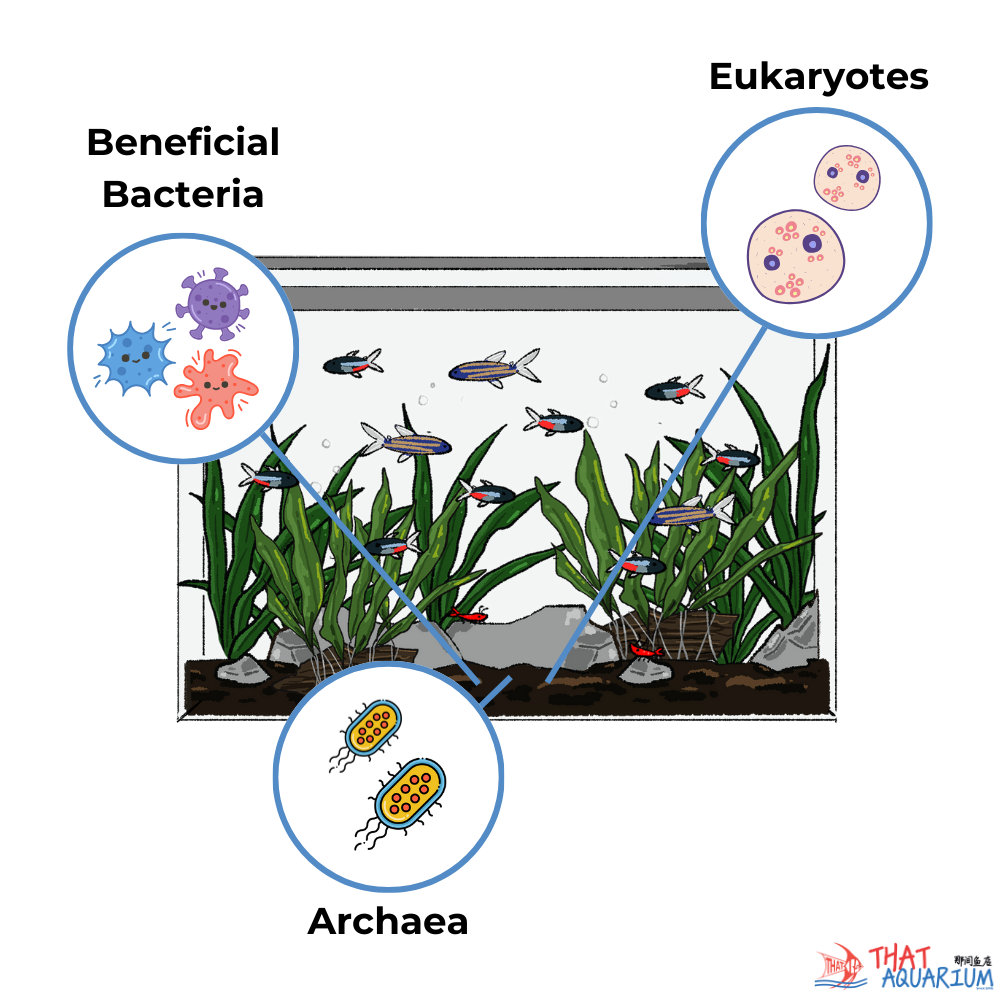
Yes, you can buy beneficial bacteria at most aquarium stores to seed your aquarium filter, but the real magic happens when these beneficial microorganisms naturally occur in your aquarium. They are Nature’s unsung heroes – a natural clean up crew that we first learnt of through Science, termed as the ‘nitrogen cycle’. Why nitrogen? Well, organic wastes are mostly nitrogenous in their makeup. And the role of beneficial bacteria, as well as archaea and eukaryotes, is to consume nitrogenous wastes as a source of “food”. In the process, they help to render toxic organic wastes into their less toxic form. Lastly, these less toxic wastes are finally reduced to nitrogen gas that dissipates out of the aquarium into the atmosphere. While some of those wastes end up as food for aquarium plants (if any) in your aquarium.
Here is an illustration to show you the nitrogen cycle process:
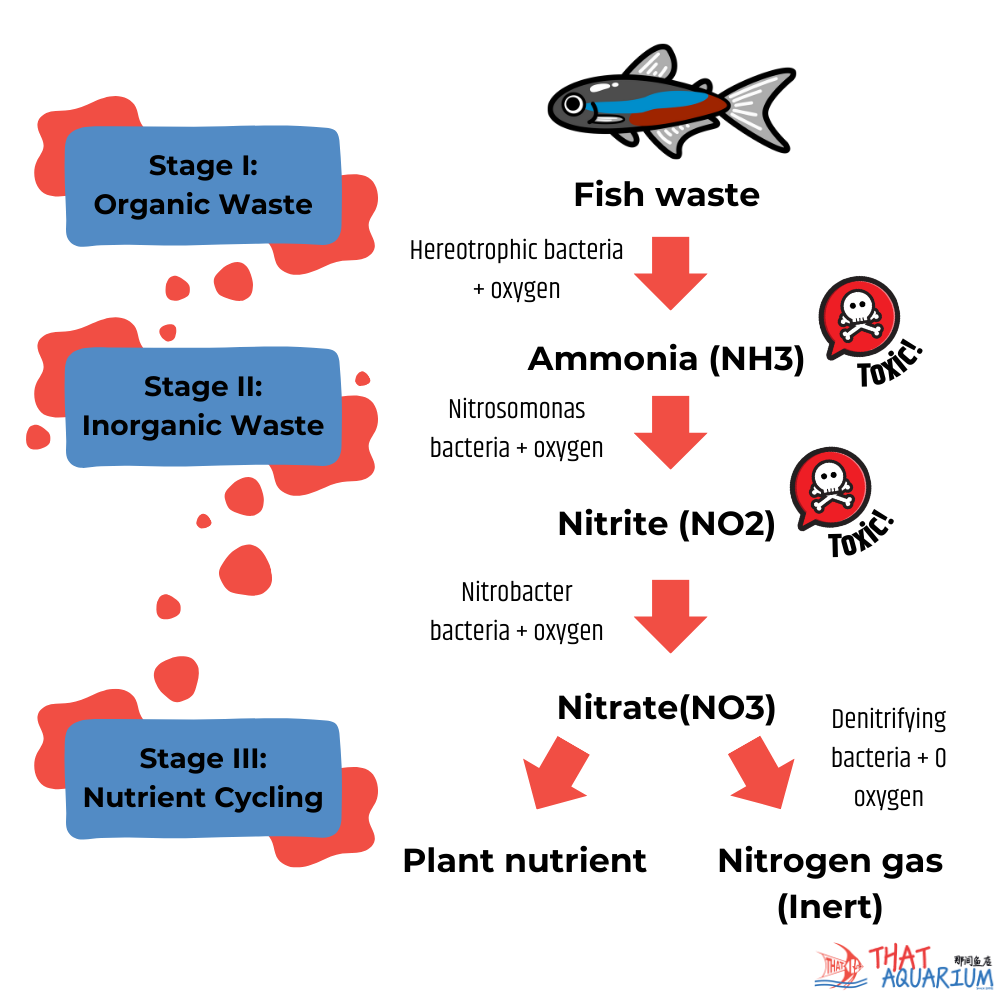
Voila! The end product of the nitrogen cycle is nitrogen gas, an inert (non-toxic) gaseous compound. So, how can you, as a beginner, establish a biologically stable, healthy aquarium like the experts do? Simply by following these expert tips:
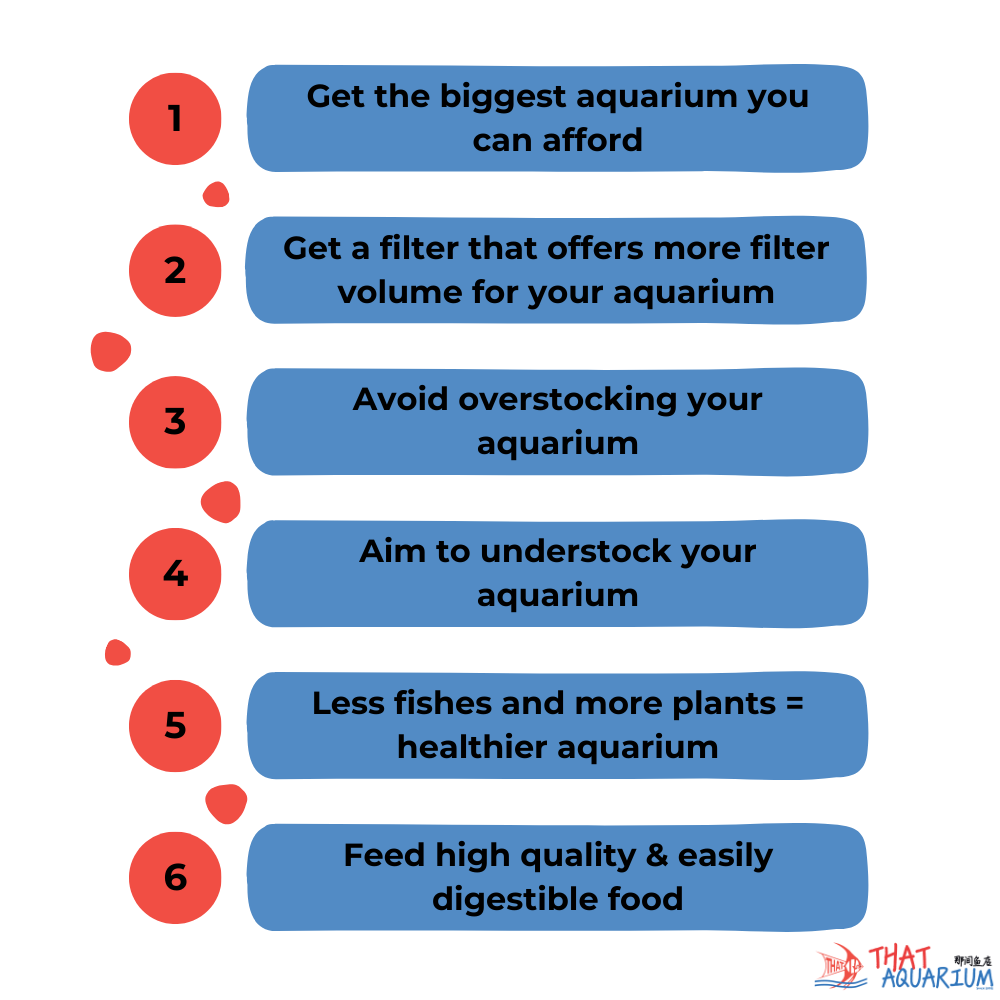
Now, has it become apparent how vital the nitrogen cycle in your aquarium is? But there is no way of sustaining a healthy aquarium without it. The good news is once the biological stability of your aquarium is firmly established, your aquarium requires minimal intervention. An established aquarium is more than just a glass box with fish in it – it is an ecosystem that can support life!
And it is this aspect of the aquarium hobby that truly feels very satisfying! No other pet-keeping offers you a chance to create a small world for your beloved pet quite like an aquarium hobby does, where you get to observe an array of natural behaviors in fishes, from their unique quirks to the joy of seeing young fishes being born in your aquarium!
The cycle of life and Nature is at arm’s reach in the comfort of your home! Imagine that!
From bacteria to a thriving ecosystem filled with healthy, colorful fishes swimming with their young.
Every familiar hobbyist was once a beginner, just like you, now. And it did not take them long to master their own aquarium. It just took them LOVE—to never give up and to understand how fish show us their love for us in return when we take care of their needs.
As we discussed earlier, the accumulation of fish metabolic waste products leads to the buildup of ammonia, a toxic compound that is then converted to nitrite (still a toxic compound) via the nitrification process, which harnesses the power of beneficial bacteria. Thus, this begs the question: How do ammonia and nitrite toxicity affect our aquarium inhabitants?
Ammonia and nitrite can pose a severe threat to the health of our aquarium inhabitants. Findings indicate that ammonia levels in water at readings between 0.5mg/l and 22.8mg/l and nitrite levels above 0.5mg/l are both deemed toxic to aquatic life. This is not to exclude nitrates that, while the least harmful of the three nitrogenous waste compounds, can still induce health issues in fish if allowed to accumulate at concentrations of 40 mg/l or more. Thus, ammonia nitrite and nitrate toxicity affect the health of our aquarium inhabitants in different ways. Therefore, we must ensure that all three nitrogenous waste compounds do not reach critical levels by ensuring that the aquarium is not overstocked and its inhabitants are not overfed.
The symptoms of ammonia toxicity in fishes are evidenced by lethargy, in which a fish remains motionless at the bottom of the aquarium and disinterested in normal activities such as foraging for food. At the same time, its fins will be clamped as though the fish were paralyzed. Why so? Ammonia burns the gills of the fish. This results in impaired gill function, leading to distress in normal bodily functions. In severe cases, prolonged exposure to high levels of ammonia may even turn a fish’s normal and healthy reddish gills purple, and this will then be accompanied by gasping at the water surface due to the gills being unable to absorb oxygen efficiently. Finally, extreme symptoms of ammonia burn will even cause the fish’s finnage to appear as they are “melting” or rotting away. The lack of immediate intervention to save the fish at this critical stage will result in the fish’s death via gradual attrition.
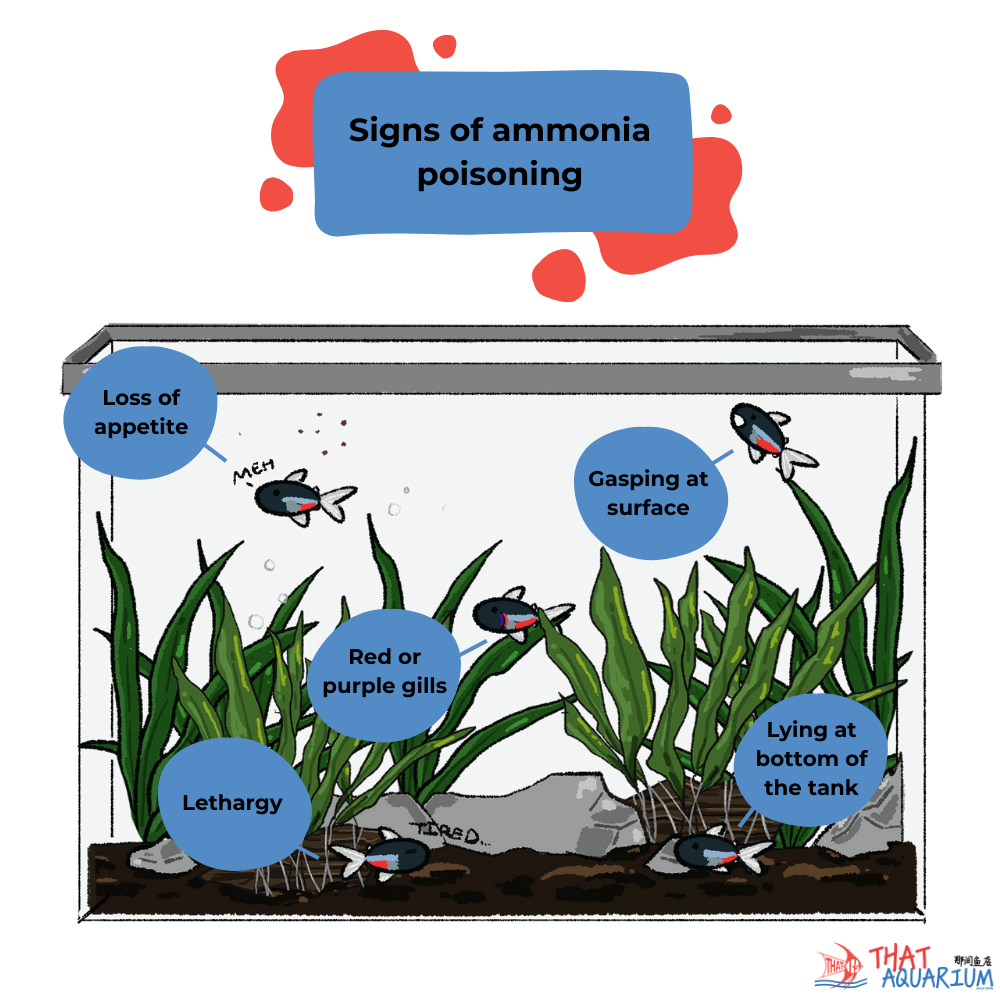
Before we discuss the effects of nitrite toxicity and how it affects aquarium fishes, it is worth noting that ammonia becomes less toxic in low pH conditions as it converts from ammonia (NH3) into ammonium (NH4+). In the pH section, we will explore this later and its effects on fish health. Unfortunately, in the case of nitrite, pH is not a determinant of its toxicity. The latter can manifest as several symptoms of distress in fish.
Nitrite levels at dangerously high levels (above 0.5 ppm) can prove toxic by negatively affecting blood oxygen uptake in fish and causing blood to turn brown due to a build-up of methemoglobin. Here, the red blood cells cease to transport oxygen, and the fish suffocates, even if the surrounding aquarium water has a high dissolved oxygen concentration.
Certain species of fish may be able to tolerate exposure to high levels of nitrite, but even then, an accumulation of methemoglobin will lead to damage to the liver and eventually compromise the fish’s immune system. This will open up a plethora of secondary infectious diseases to strike, causing the infected fish to finally succumb and die off.
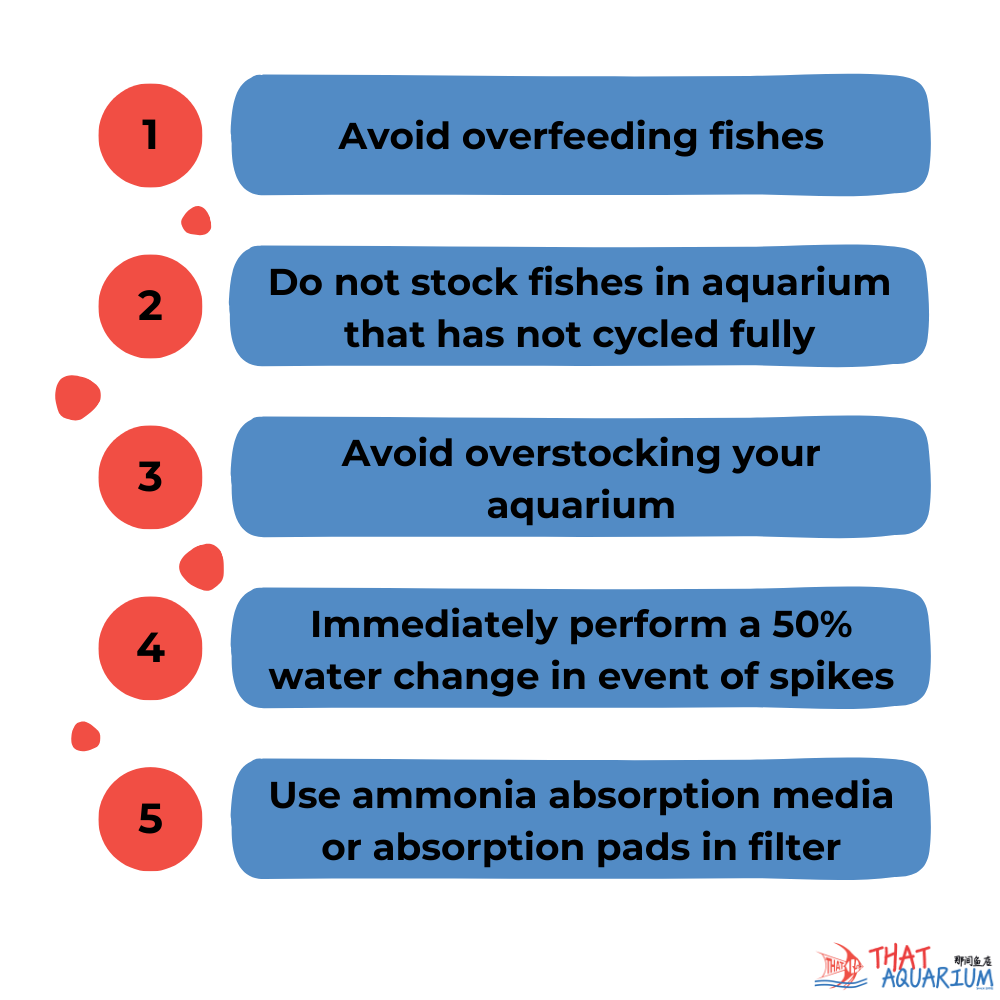
Finally, we are left with nitrate at the end of the nitrification process that occurs in the presence of oxygen. While considered the least toxic form of nitrogenous waste compounds, nitrate levels can still accumulate in concentrations that negatively affect fish health. It is, after all, still a waste compound. Which can be absorbed into the fish’s body, and the liver converts it back into ammonia, which the fish then excretes as waste via its gills. Fortunately, aquariums that feature live plants growing both in and above the aquarium water help to absorb the bulk of nitrate as a nutrient.
Also, both water changes and the use of a denitrifying filtration media will effectively reduce nitrates. This leaves us with a question: At what concentration levels is nitrate toxic to fish? In all honesty, there is an ongoing debate among the experts, with some Scientists raising the alarm for iterate toxicity at over ten ppm. In comparison, others shrug off any potential harm caused even at levels encroaching 100 ppm. What are the ideal levels for a beginner regarding effective nitrate management?
For the beginner, it is simply a matter of not being paranoid over exact levels of nitrate concentrations in the aquarium water, as there are means of diluting excess nitrates before they reach 80 ppm, such as water changes and the use of nitrate adsorption media. All of which are easily applied in practice. Fret not! In an established, fully cycled aquarium where weekly water changes are performed, and overfeeding/overstocking is avoided, keeping nitrates below the recommended 20-40 mg/l concentration levels should come with no difficulty. Again, it all boils down to aquarium upkeep, so a healthy aquarium equals healthy water for your fish. It is that easy.
Question : “I’ve heard of ‘ nitrate shock’ – what is it?”
When nitrate actually tends to pose a problem is when a hobbyist introduces a new fish from, say the aquarium store or even another aquarium where nitrate levels were significantly lower. This sudden influx of high nitrate in the new environment causes sudden stress i.e. shocking the fish. Thus, causing several symptoms to occur : acting listless, loss of appetite and even curling of its body from head to tail. Disheartened, yet? Don’t be. Here is a simple way to avoid ‘nitrate shock’.
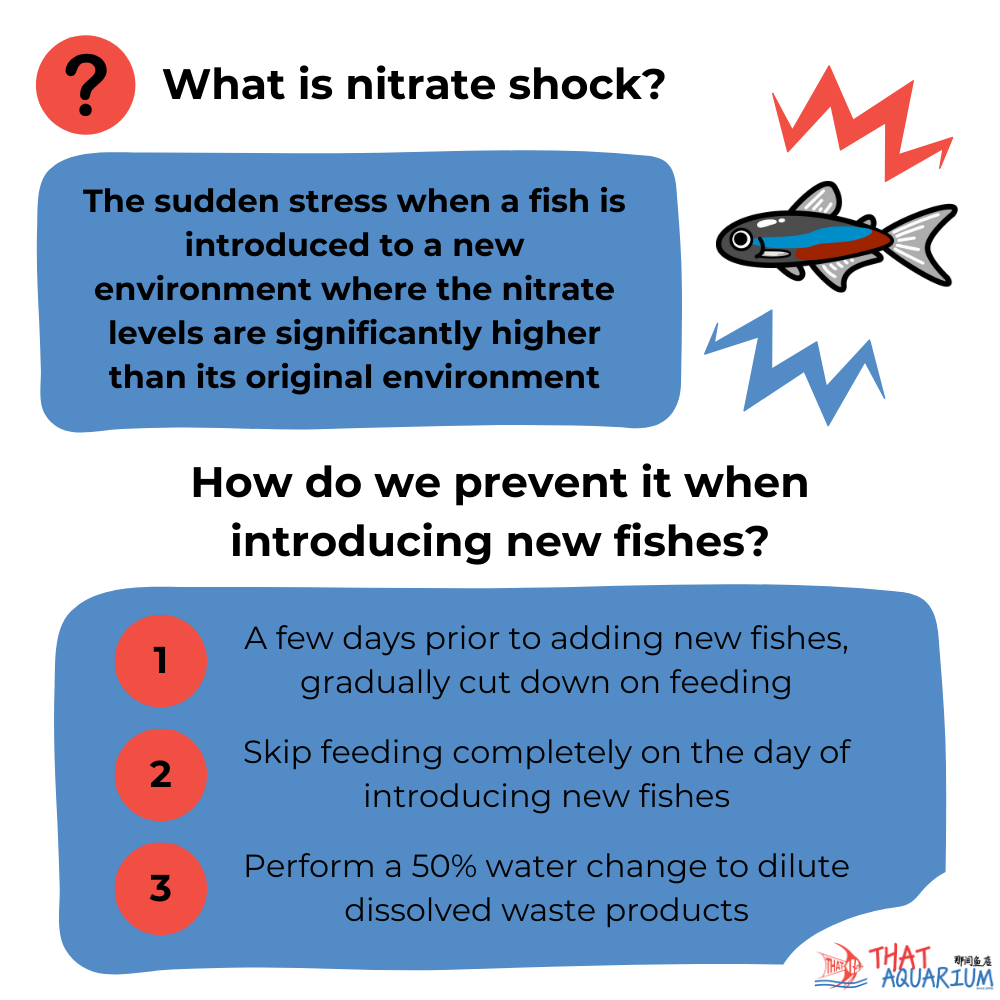
Prior to introducing new fishes to your aquarium, do this. Over the course of a few days, gradually cut down on feeding i.e., underfeed your fishes and finally, skip feeding completely on the day you wish to buy new fishes / introduce new fishes from another existing aquarium. Do not worry underfeeding your fishes for a brief period will not harm them. In fact, institutionalizing a day of fasting, once a week is beneficial for gut health; allowing a fish to clear its gastro-intestinal tract of waste matter.
Next, perform a 50% water change. This should dilute a lot of the dissolved waste products in the aquarium water, including excess nitrates. Which can help to prevent nitrate shock from occuring when the new fish(es) are finally being introduced. Such a simple measure, when applied can mean the difference between a smooth transition of the new fish from its untimely demise. So, yes water changes are your best defense to guard against nitrate induced problems from affecting your new aquarium procurement(s).
Nitrate toxicity, on the other hand, occurs as a result of neglect of the aquarium i.e., poor maintenance which causes a steady build up that can lead to health symptoms such as nitrate shock; which we have discussed earlier.
Alright Now! For the more exciting topic. So, at this juncture, we have emphasized the importance of keeping ammonia, nitrite, and nitrate levels low (and within acceptable levels in the case of nitrates). Are there other factors that are critical in ensuring fish health? Yes, there are, but first and foremost, what does fish health imply?
Fish health can be defined as a state of optimal vigor, free from diseases, and, most importantly, the ability to exhibit normal behaviors that are both fundamental (e.g., foraging for food, displaying perceptivity to external stimuli) and existential (e.g., showing interest in conspecifics for breeding, displaying normal coloration that is characteristic of the species). Generally, the fish should appear stress-free to the observer. Stress is the number one trigger of fish health-related issues in the captive aquarium environment.
The first critical step to reducing stress in aquarium fishes is ensuring that your chosen aquarium is manageable for your intended fish collection. Generally speaking, new hobbyists tend to purchase relatively small aquariums intended for housing diminutive fish species, aka nano tanks, but then choose unsuitably large fishes relative to their tank size. This is often based on a flawed presumption that a fish’s home can be “upgraded” with time and “a fish will not grow larger than its aquarium.”
Both presumptions are wrong. We’ll explain why. Firstly, fish do not stop growing! A fish will continue to replicate its cells and grow to sizes typical of the species. The only time a fish stops growing is when it has been unaltered. So, suppose you kept a juvenile Oscar Cichlid, which can reach an adult length of 30 cm, in a tiny 20 cm long fish tank. In that case, it will live only to suffer from poor water quality due to an ever-increasing waste load as it grows; plus, the lack of space for it to display natural swimming behavior will lead to muscle atrophy. The muscles become deformed gradually due to the lack of mobility. It is animal cruelty against the fish when, instead, a better approach to tank stocking can produce a thriving display aquarium that not just you but your fish will enjoy!
As for an upgrade down the road, while that is certainly an option in reality, a hobbyist can do no better than to provide a stress-free living environment for the fish with the sole intention of creating a stable, permanent home. Understand that moving a fish around often is a stressful procedure. Fishes should only be moved when necessary. Examples of the latter include :
Common Mistake made by Beginners: Net out the fish to a pail when performing tank maintenance.
That’s it! We do not move a fish out of its aquarium during water changes. To some extent, aquarium maintenance is considered a disruptive, stress-inducing practice. Thus, it becomes critical to recognize stressors that can negatively impact our fish health, which we can avoid as much as possible. Alas, get the biggest tank size your intended fish species will thrive in or, at least, a tank it can get by living comfortably in.
Once an aquarium size has been chosen, setting up a natural living environment will go a long way in ensuring that your fish thrive and are stress-free. They will amaze you with their dazzling colors and array of interesting behaviors. And you can do no better than to include live aquarium plants as part of your aquarium layout. Try to include at least easy-to-grow plant species in your tank.
While not necessarily a planted tank by intent, having live plants in your aquarium entails many benefits for the fish living alongside the greenery, such as helping to prevent excess nitrates from accumulating, taking in and storing up toxins dissolved in the water, oxygenating the aquarium during periods of illumination, giving shelter for reclusive fish species seeking respite in the form of heavy cover, and even food for fish to vary their diet. Trust us, if you probably had never seen a Congo Tetra with a little “plant cigar” with a piece of leaf to slowly chew on cruising around your tank like a boss. You’d miss out on the fun of seeing fishes doing adorably quirky things when they feel comfortable in a natural aquarium environment.
Another great way to reduce stress in an aquarium is by incorporating natural decor items. Driftwood sold for aquarium use, for example, can emulate riparian growth found in many freshwater habitats where fishes dwell. The tannic and humic acids leached by driftwood benefit fishes that hail from rainforest habitats. Otherwise, you can use aquarium-safe rocks to create sheltered areas for fishes such as catfish to rest on, water, or behind. Natural decor items are the route to aquarium decoration. Plastic plants/ornaments are less desirable.
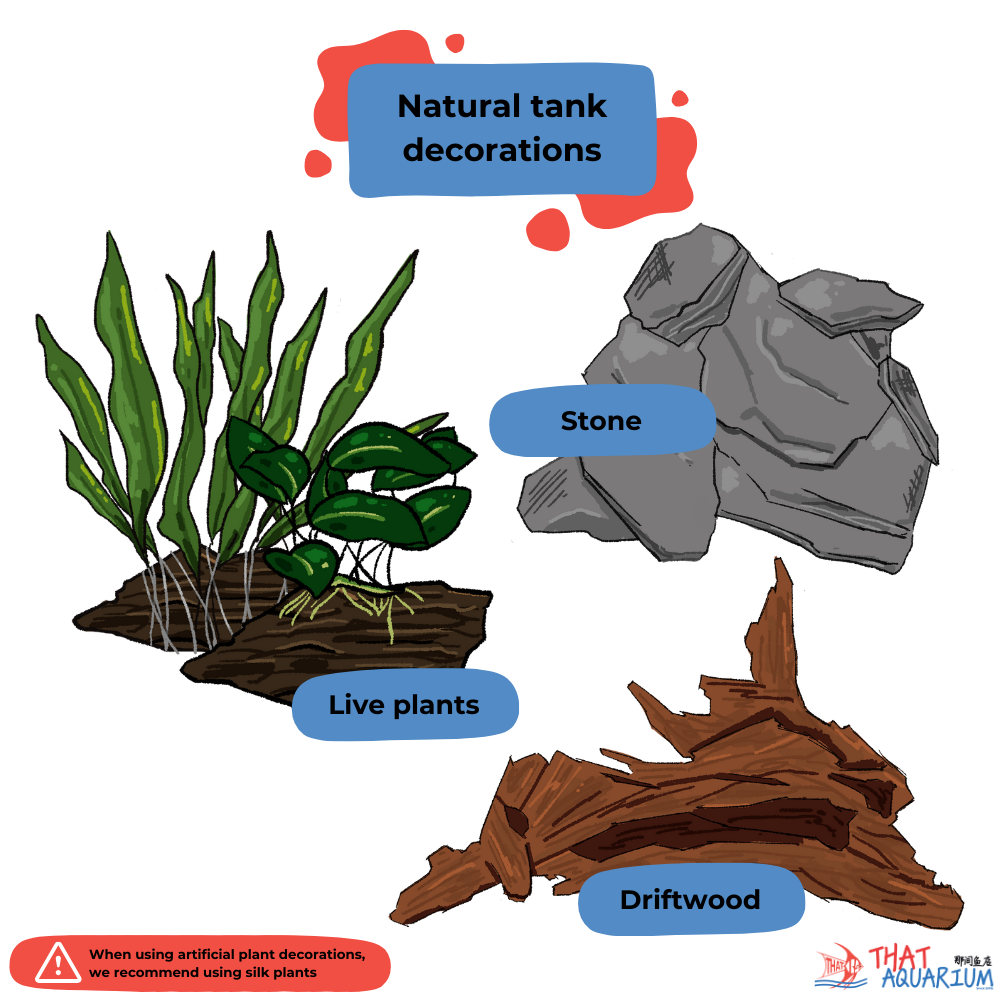
Oxygen is a gas which is vital for sustaining life. We breathe in oxygen like plants (when they respire at night), and fish are no different. The end product of respiration is carbon dioxide. The thing is, underwater respiration differs from ours on land since water is 830 times denser than air, which means there is 20 to 40 times less oxygen in water than air by the same volume. But, if we didn’t provide the means to ensure adequate oxygen levels were sufficient in the aquarium water, fish would quickly succumb to stress-inducing respiratory problems and eventually perish from hypoxia (inability of the blood cells).
Before we learn about providing adequate oxygen to our aquarium inhabitants, we must first see the big picture by identifying what living creatures within our aquarium require oxygen constantly. They are :
Yes, many living things—not only the fish you can see — are consuming oxygen in your fish tank! Their need for oxygen, coupled with the fact that water holds less oxygen than air, creates what is known as biochemical oxygen demand (B.O.D.), which is measured in milligrams of oxygen/liter. Relax; we need not delve too deep into B.O.D. as long as we ensure oxygenation methods are set in place for our aquarium.
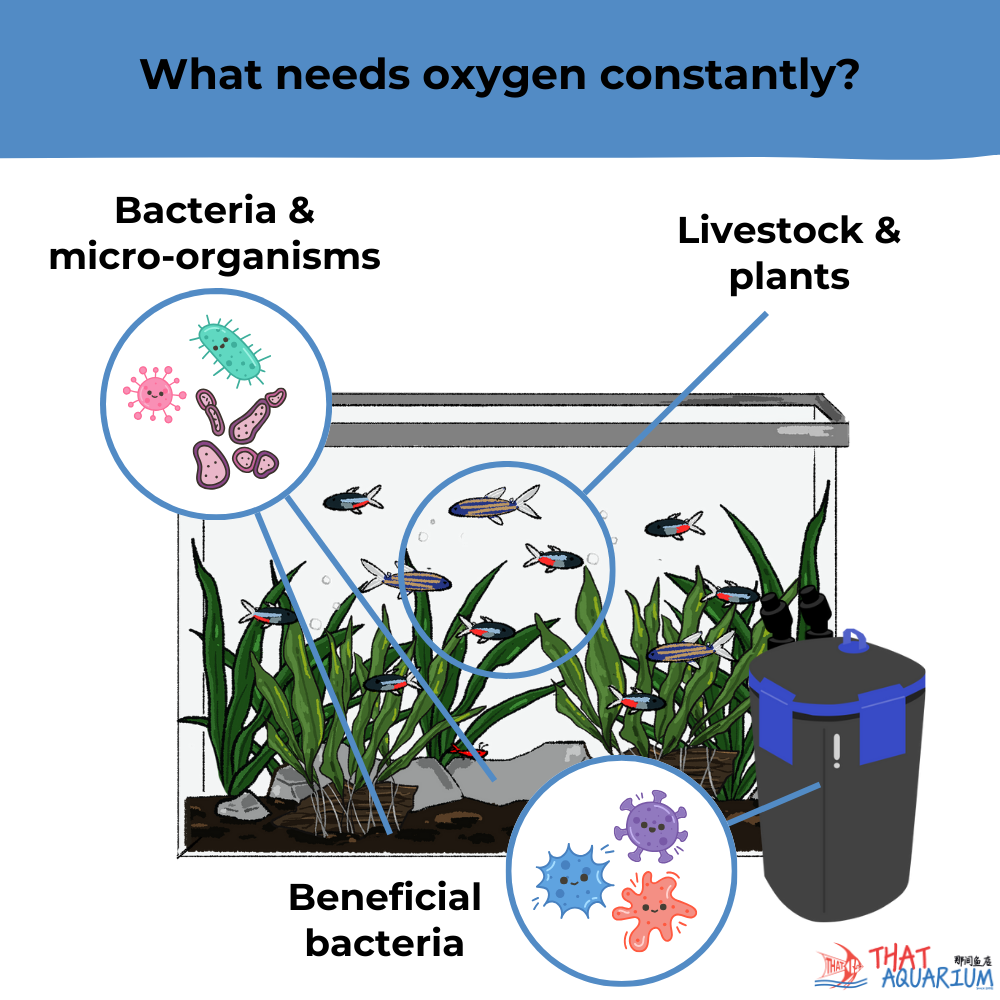
So, how do we ensure that adequate oxygen levels are met for the optimal health of our aquarium inhabitants? The most commonly applied techniques are by injecting air directly into the water column via the use of an air pump and water surface agitation.
Surface Agitation and Gas Exchange
Water movement at the surface, caused by filters, air stones, or powerhead, creates agitation.This agitation disrupts the water surface, increasing the contact area between air and water. Oxygen from the air dissolves into the water, while carbon dioxide is released into the air. This exchange is facilitated by the increased surface area and turbulence created by surface agitation.
Aeration Device
Aeration is defined as the introduction of air into a material. The latter, in this case being a liquid medium, water. Note that while air is being introduced into the aquarium water column, it does not impart atmospheric oxygen.
Air stones and bubble wands introduce air bubbles into the water, which rise to the surface and burst. As bubbles move through the water, oxygen is transferred into the water column and helps with gas exchange at the surface when they burst.
One benefit of an Air Pump
Thus, the brief but continuous uprising of air bubbles drives off the toxic waste gas, carbon dioxide (Co2) into the atmosphere and this ensures that an excessive buildup of Co2 does not displace vital oxygen in the water. Put simply, running an air pump on an aquarium ensures that your oxygen levels will be consistently higher than carbon dioxide levels building up in your aquarium from fish, bacterial and plant respiration.
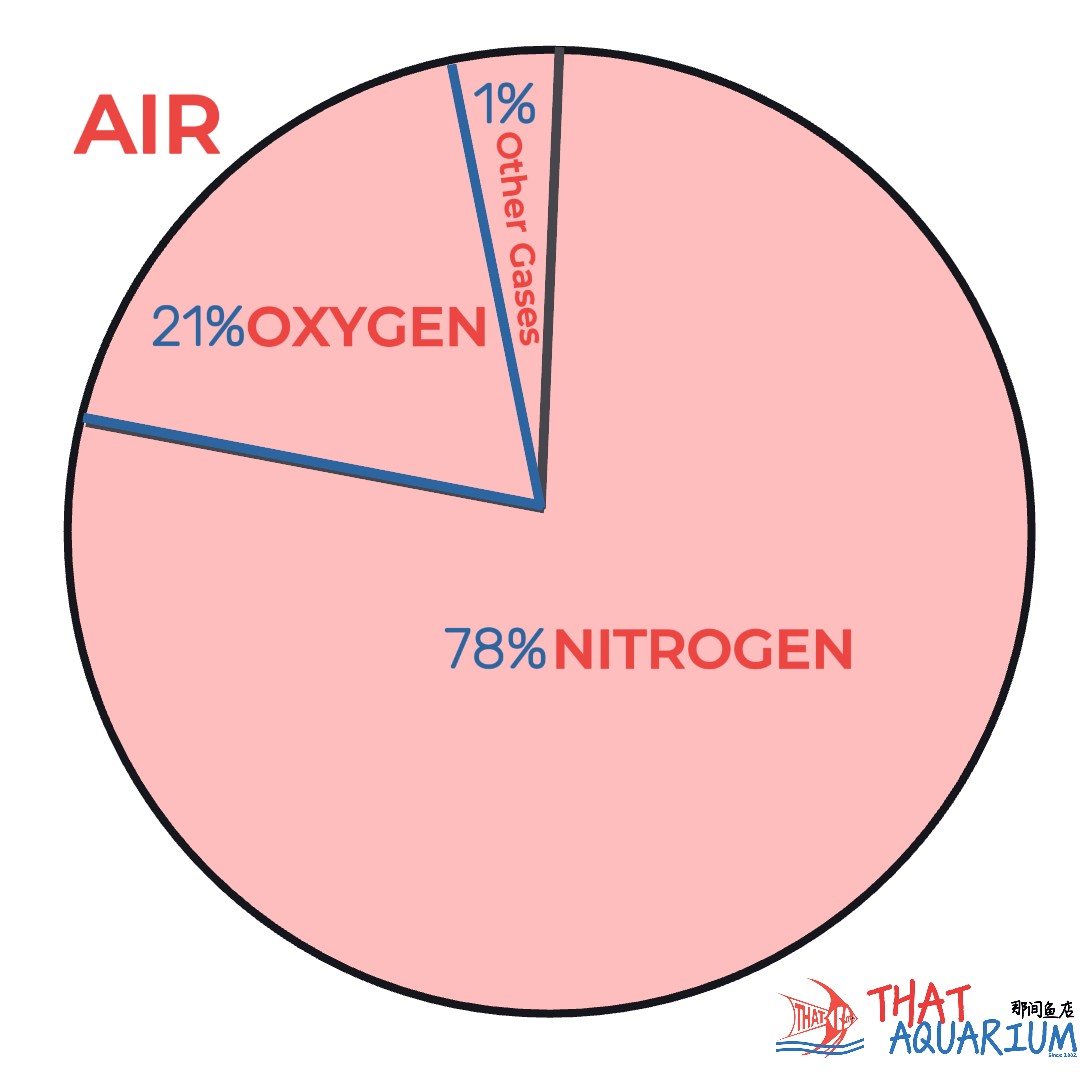
Stocking Levels
The more crowded your tank is with fish? The higher the tank’s biochemical oxygen demand B.O.D levels will be. Therefore, avoid overstocking your aquarium with fish.
Aquarium Dimensions
The taller or deeper your tank, The less efficient aeration becomes. Remember, shallower tanks offer greater surface area for gaseous exchange than tanks of the same volume, so avoid unusually tall/deep tanks that deviate from the standard tank dimensions.
Aquarium Plants
In the presence of light, plants use photosynthesis (make food) and take in Co2 during that process to obtain carbon to make sugars. Oxygen gas is released during photosynthesis, so having live plants in your aquarium does entail the added benefit of directly adding oxygen into the water column. This phenomenon is most evident in a dedicated, high-tech planted aquarium in which extremely high photosynthesis rates cause plants to “pearl,” i.e., release large amounts of oxygen bubbles continuously during the tank’s photoperiod hours.
Filter Turnover Rate
A filter pump that circulates the aquarium water at an optimal rate (4 to 5 times the tank volume per hour) ensures that gaseous exchange happens at all strata in the aquarium by minimizing potential dead spots in the tank—yet another important function of an aquarium filter.
Fish medication
The presence of dissolved chemicals from fish medications can also affect oxygen availability by binding onto oxygen molecules (oxidation). An example of this is the oxidation of malachite green, a copper-based compound used to treat white spot disease in aquarium fishes.
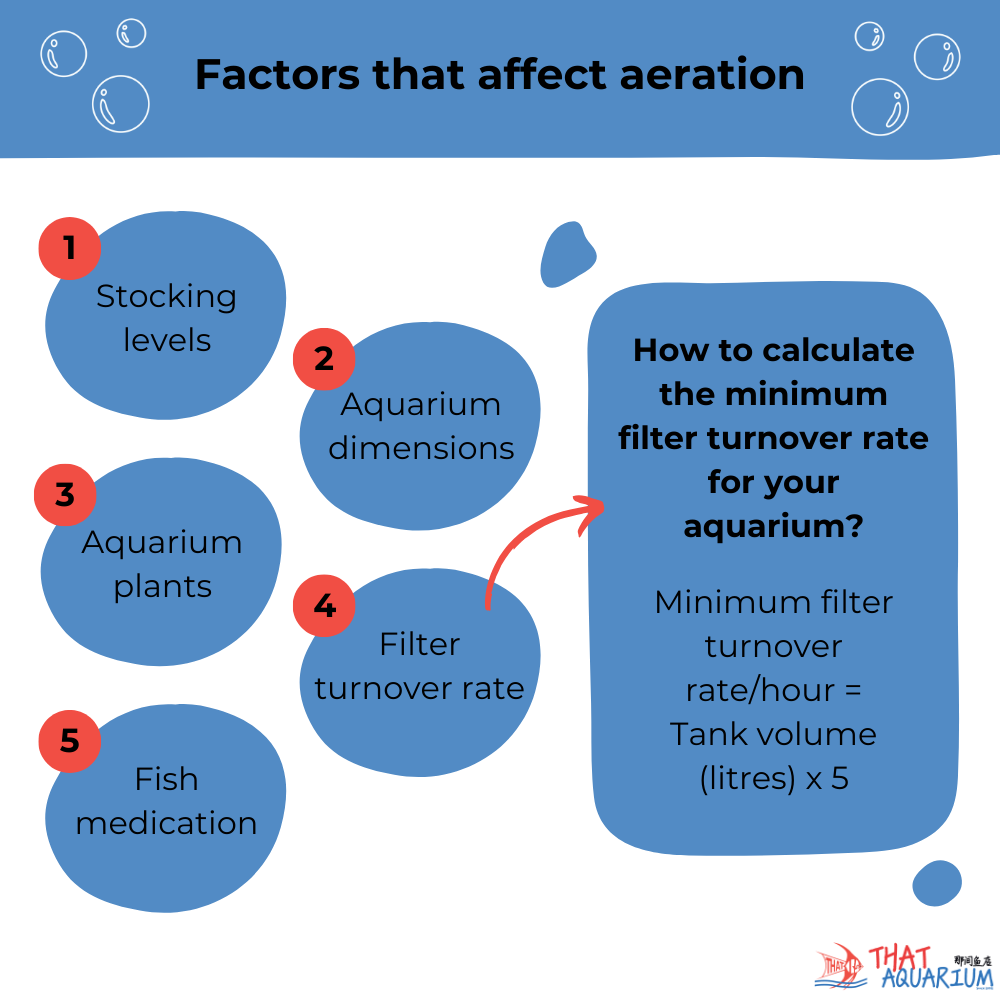
As mentioned earlier, the vast species of fish that exist have adapted to each of their preferred pH range. Each species has evolved to exploit its habitat. Still, while certain species are exacting in their pH needs due to the very niche nature of the habitat (e.g., soft, acidic pH of peat swamp waters), the overwhelming majority of aquarium fishes can adapt to a wide pH range, provided extremes are avoided.
Also, as mentioned previously, there is a direct correlation between pH and KH. KH acts as a buffer to prevent rapid downward shifts in the aquarium’s pH levels. How so? We must understand that life processes occurring in our aquarium are the biological breakdown of organic compound acids.
For example, when beneficial bacteria convert ammonia into nitrite, nitric acid is produced. Over time, the accumulation of nitric acid can dissolve the KH of the aquarium water. Therefore, without sufficient buffers, the pH levels begin to decline very quickly, causing undue stress to aquarium fishes as their body fails to cope with the rapidly changing pH levels that are outside of their natural tolerance range.
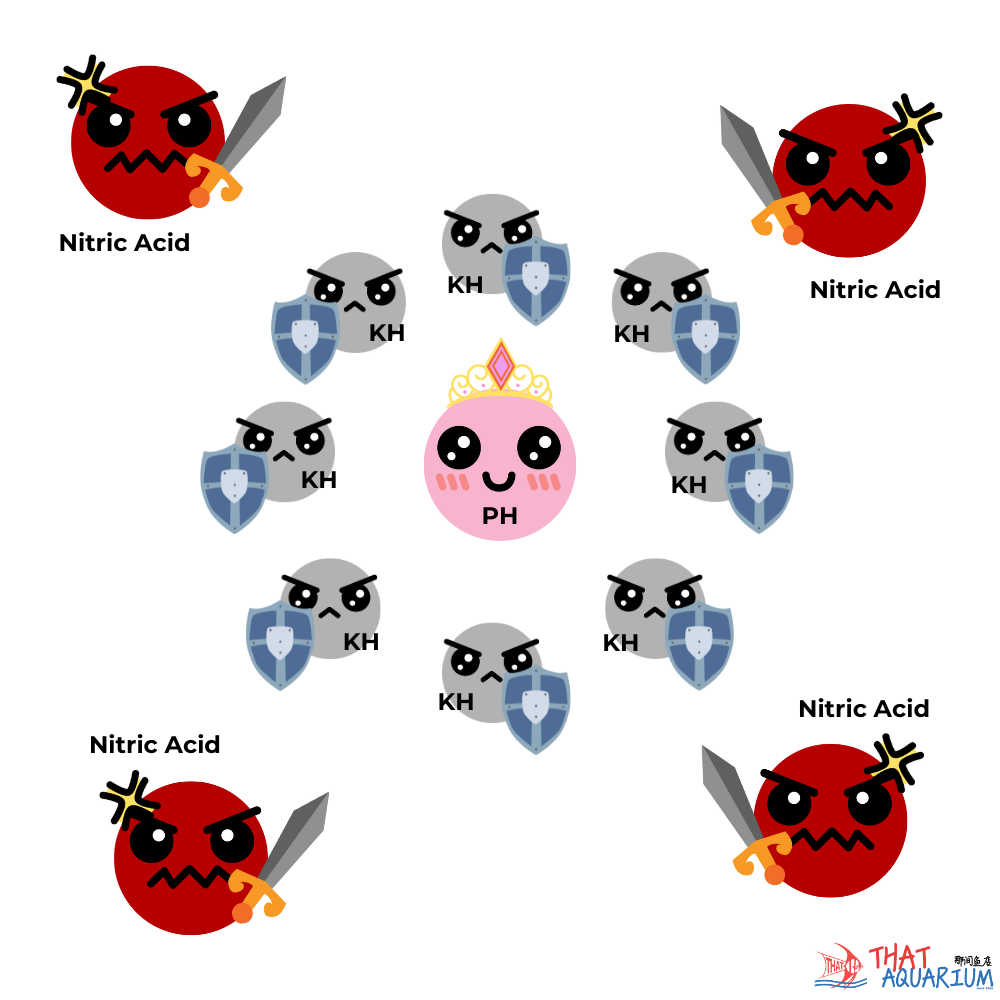
While KH powder can be supplemented via off-the-shelf products and the addition of calcareous filter media such as crushed coral and aragonite, which slowly re-introduces KH buffers safely, the true, tried-and-tested way of ensuring that organic acids do not build up to dangerously high concentrations is by performing periodic water changes. Remember, water is a universal solvent; therefore, water change helps dissolve most unwanted compounds via displacement and dissolution.
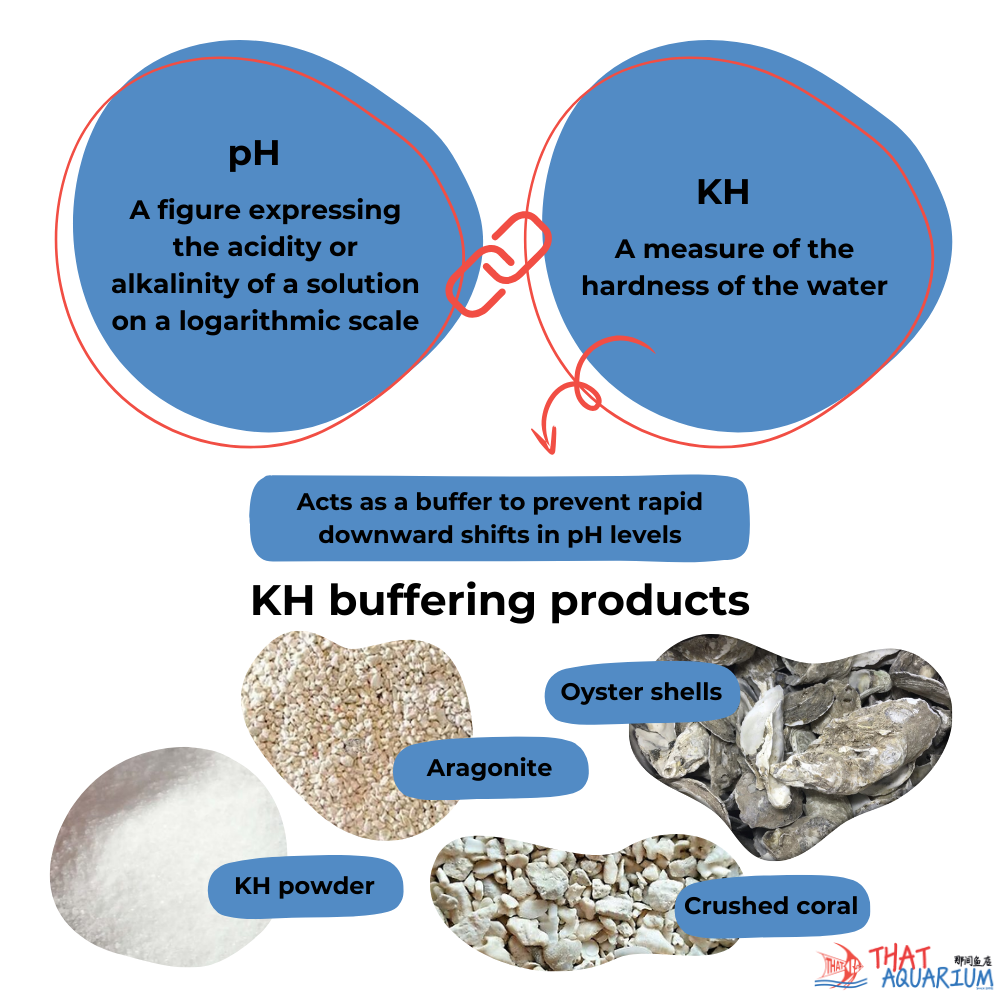
Aquarium ownership offers a unique and rewarding hobby, creating a mini-ecosystem for fish. Maintaining biological stability is crucial, involving beneficial microorganisms that convert toxic fish waste into less harmful compounds. Key to this process is the nitrogen cycle, which reduces waste to inert nitrogen gas. Beginners can establish a stable aquarium using larger tanks and adequate filtration, avoiding overstocking and feeding quality food.
Ammonia and nitrite toxicity pose significant risks to fish health, manifesting in symptoms like lethargy and respiratory distress. Managing these involves proper stocking, feeding practices, and immediate water changes during spikes. Nitrate accumulation, while less toxic, can still harm fish if not kept in check through water changes and plant absorption.
Fish health hinges on minimizing stress, which can be achieved by choosing appropriately sized tanks, incorporating live plants, and ensuring adequate oxygenation through surface agitation and/or aeration devices. Stability in pH and KH levels is also vital, preventing stress from rapid shifts. Maintaining an aquarium involves creating a balanced, stress-free environment where fish can thrive.
Proudly presented by our That Aquarium Digital Team, where innovation meets aquatic excellence.
Published on 13 June 2025
Author: Saufi
Illustrator(s): Jolin Lee, Nor Haliza, Chai Minyu, Kelvin Phua, Abbie Tan
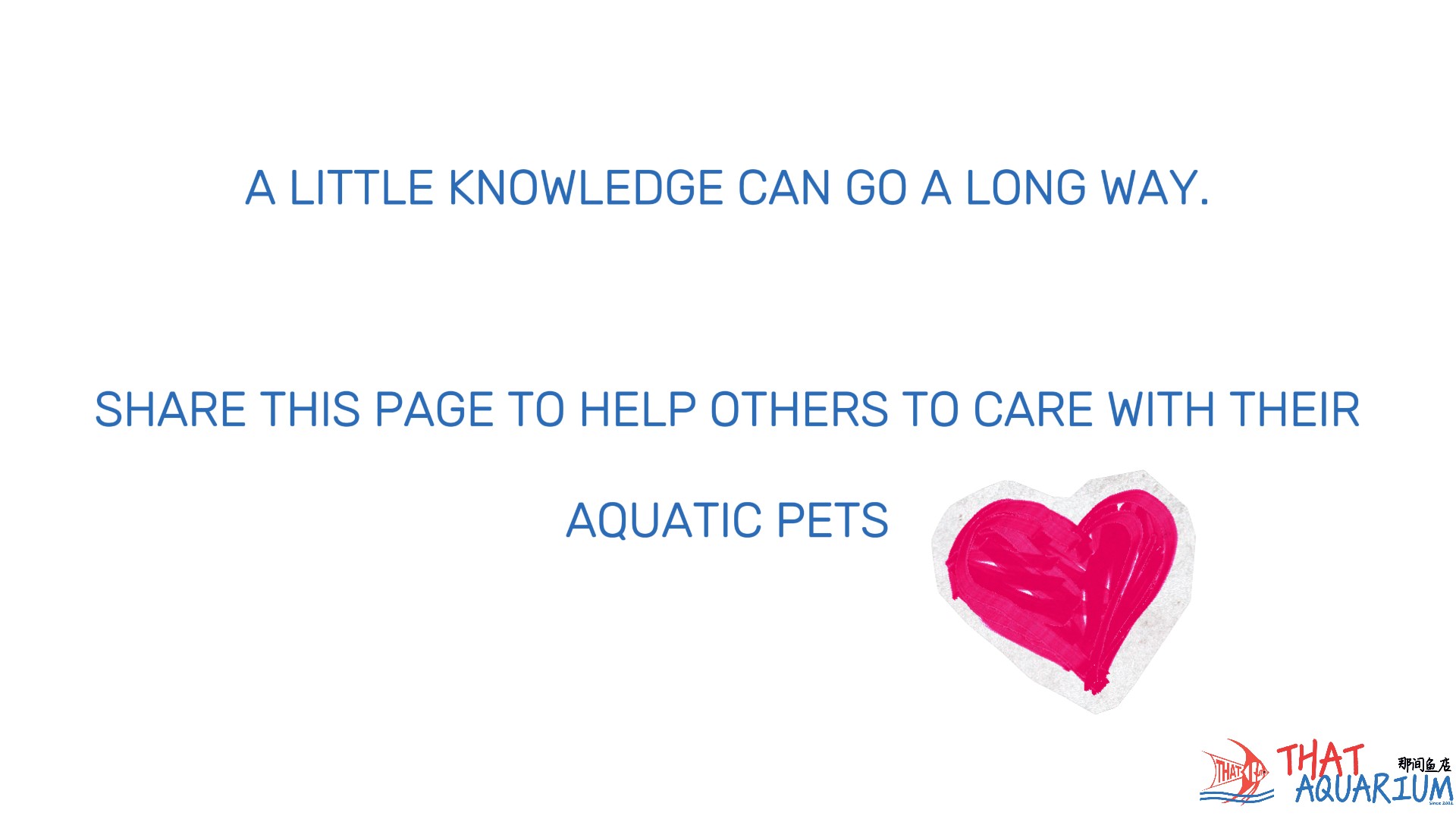

At That Aquarium, we believe that exceptional CARE is the foundation of our success. We are committed to treating each customer and every aquatic life with genuine compassion and respect. Our dedication goes beyond providing quality products and services; we strive to create a nurturing environment that delivers a therapeutic experience for our customers, our aquatic life, and our team. Guided by principles of integrity, forward-thinking mindset, and continuous improvement, we aim to foster a harmonious and supportive atmosphere. Our focus is on ensuring that every interaction reflects our dedication to excellence and our care for both our people and our community.
That Aquarium